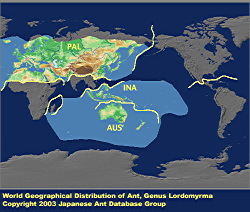
|
genus
|
Lordomyrma
|
 |
Japanese Name
|
Mizogashira-ari-zoku
|
Original Reference
|
|
Emery, C. (1897) Formicidarum species novae vel minus cognitae in collectione Musaei Nationalis Hungarici, quas in Nova Guinea, colonia germanica, collegit L. Bir. Termszetrajzi Fzetek 20: 571-599.
|
Synonym
|
|
Lordomyrma Emery, 1897c: 591,
Prodicroapsis Emery, 1914f: 414,
Promeranoplus Emery, 1914f: 412
|
Description
|
|
Total length of workers around 3 - 5 mm. Clypeus raised medially, and with paired longitudinal carinae; anterior margin projecting forwards over mandibular bases. Antennal scrobes distinct in many species, but indistinct in some Melanesian forms. Antennae 12-segmented; the apical 3 segments forming a club. palpal formula 4:3 in Japanese species. Promesonotum raised; metanotal groove distinct. Propodeum with distinct paired spines. In some exotic species the propodeal spines extend over the petiolar node, and spines are present on the pronotum and/or petiole. Integument thick.
|
|

|
Remarks
|
|
Rare ants. The genus includes about 10 described species, most of which are found in New Guinea, eastern Australia and adjacent islands. There are many undescribed species (Taylor, pers. com.). Imai et al. (1983) reported an undetermined species from the Malay Peninsula, and others have been collected in the Malay Archipelago (Taylor, pers. com.). In Japan Lordomyrma is represented only by L. azumai Santschi. It is the most northerly-distributed known member of its genus.
|
Editor
|
|
Original text by Kazuo Ogata and Masao Kubota. English translation by Kazuo Ogata, edited by Robert W. Taylor.
|
|